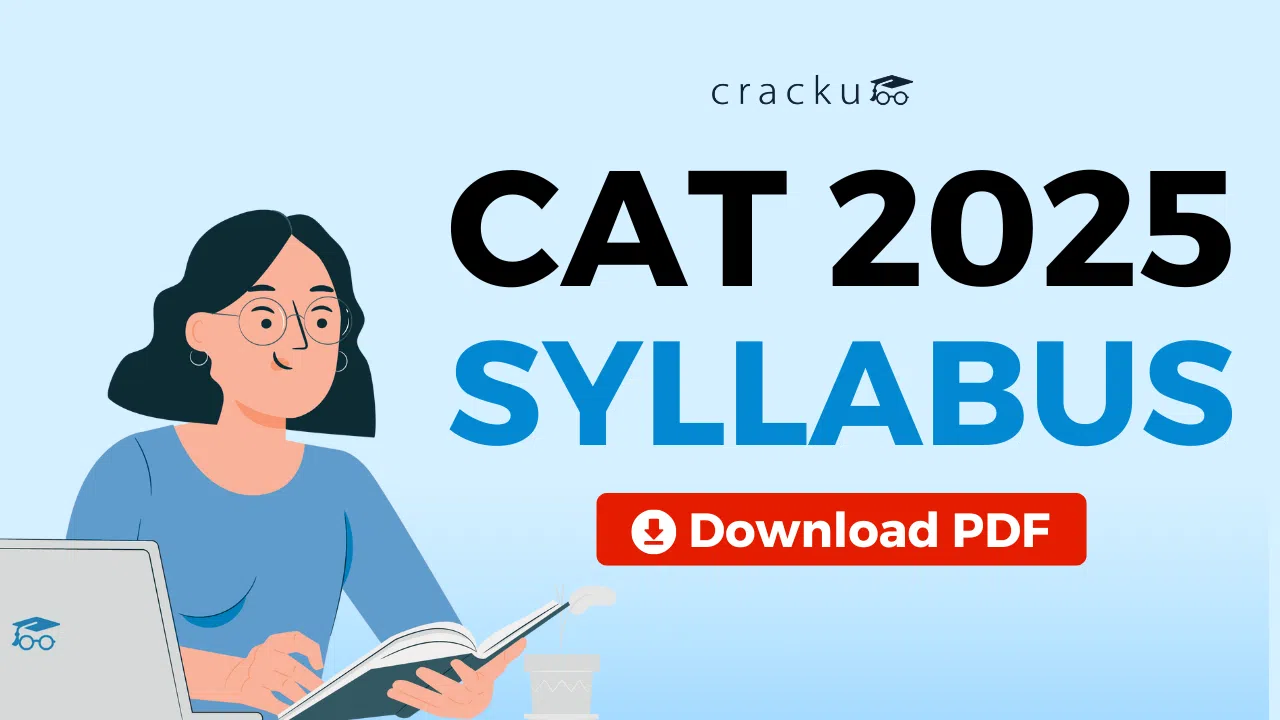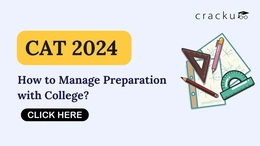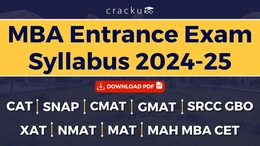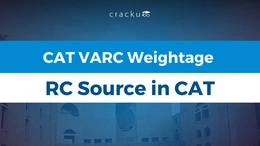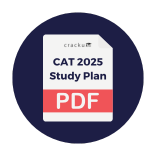CAT exam is a management aptitude test conducted by IIMs to evaluate and shortlist candidates for MBA programs. This article presents a section-wise strategy to cover the CAT Syllabus 2025. Aspiring candidates must stay updated on the topics and patterns in the CAT exam Syllabus. Find the latest CAT syllabus for 2025 below with a section-wise breakdown and effective preparation strategies.
CAT Syllabus 2025: Overview
CAT syllabus consists of three section namely, VARC section, LRDI section and Quantitative Aptitude (QA) section. A candidate is thoroughly judged on the basis of his/her logical skills, English proficiency and quantitative skills. Lets' deep dive in the syllabus section of this exam.
| CAT 2025 Sections | Section Overview | Number of Questions |
| Verbal Ability and Reading Comprehension (VARC) | The VARC section measures English proficiency skills. | 24 |
| Logical Reasoning and Data Interpretation (LRDI) | The LRDI section tests the logical reasoning and data interpretation capabilities | 22 |
| Quantitative Aptitude (QA) | The Quantitative Aptitude (QA) evaluates the mathematical aptitude. | 22 |
CAT Syllabus 2025 Download PDF
The CAT 2025 syllabus PDF is available on the Cracku website. Students can download it directly by clicking on the button given below. Students can download the CAT syllabus PDF to prepare for the examination. IIM Kozhikode shall release the exam dates and CAT exam pattern through an official notification on its website by the last week of July 2025 (tentative). If you are preparing for other entrance exams checking with OMET Exams Syllabus will help you know the sections that you have to cover in addition to the current CAT syllabus.
CAT 2025 Exam Pattern
| Particulars | Exam Pattern |
| Mode of CAT 2025 exam | Computer Based |
| Slots or Sessions | 3 |
| Total number of questions | 68 |
| Total Time Duration | 120 minutes (2 hours) |
| Section Wise Time Limit | 40 minutes per section |
| Question Types | Multiple Choice Questions and Type In the Answer (TITA) |
| Marking Scheme for MCQs | 3 marks for each correct answer -1 for an incorrect answer No marks for unattempted questions |
| Marking Scheme for Non-MCQs | 3 marks for each correct answer No negative marks for non-MCQ type questions. |
| Sequence for Answering | Students must answer the sections in a specific order. The sequence for sections cannot be changed. |
CAT Syllabus 2025: Verbal Ability and Reading Comprehension
The CAT VARC Syllabus will have a dominant Reading Comprehension section with 4 Comprehensions to read. This section consists of 24 questions in the exam. In the meantime, candidates preparing for CAT 2025 can check the CAT VARC Syllabus for CAT 2025 below. Checking with the most CAT important topics will help you in knowing important areas to focus.
CAT Reading Comprehension Syllabus
Reading comprehensions consists of 16 question with 4 questions each from 4 RCs in the exam. Generally there is no fixed syllabus for RC in CAT. But according to previous year CAT exam analysis and past year CAT exam syllabus we can extract information based on topics which appear often in reading comprehensions. Some of the topics are given in the table below.
| Topics | Description |
| Philosophy | Based on Aristotle, Kant, era of philosophy which is little difficult to comprehend |
| Psychology | These are bit easier to attempt if you are well versed with these kind of articles. |
| History | It involves passages about Indian as well as about International history |
| Arts and Museum | Art and paintings has been favourite of CAT RC passages. |
| Society | These are more of general kind of articles based on societal issues. |
| Culture | Here you will find articles on different culture, people, languages etc. |
| Biology | These passages are based on core biology such as Genes, Darwin theory etc |
| Science and Technology | Scientific RCs are based on Physics, Chemistry, Space, AI related topic. |
CAT Verbal Ability Syllabus
The CAT Verbal Ability syllabus is a important part of the CAT exam syllabus, It consists of 8 questions with 2 questions each of Para Summary, Para Jumbles, Para Completion, Out of the Context. Best thing about this part of VARC section is it take less time to attempt. People generally make this mistake of not practicing enough for VA, do not do this it is a very scoring section.
| Topics | Description |
| Para Summary | Here, you will be given a short paragraph and you have to mark option which aptly summarize that paragraph. |
| Para Jumbles | Here, you will be given 4 Jumbled sentences and you have to arrange them in sequence. |
| Para Completion (Fill in the Blank) | Here, one sentence will be missing and 4 blanks will be given and you have to place the missing sentence at thee right place. |
| Odd One Out (Out of the Context) | Here, 5 Jumbled sentences will be given and 1 will be out of the context and you have to choose that sentence. |
Note: There was a slight change in CAT VA pattern in 2024. There were no Para jumbles in CAT 2024 instead there were 3 questions each from para summary and para completion and 2 questions from out of the context.
CAT Syllabus 2025: Logical Reasoning and Data Interpretation
This section consists of 22 questions in the exam. The CAT DILR syllabus is given in the below tables separately. This section is the second section in the CAT exam after VARC section. It is notoriously famous for its difficulty level. Go through each topic mention in the CAT 2025 syllabus to ace this section.
CAT Logical Reasoning Syllabus
Logical Reasoning is one of thee most important part of this section. Out of the 5 sets that come in the exam, there comes at least 2-3 sets based on the logical reasoning part. So, take this part seriously otherwise avoiding this part will prove to be a blunder in the exam. Let's deep dive in the detailed CAT 2025 syllabus of this section.
| Topics | Description |
| Puzzles | Einstein Puzzle, Matrix puzzle and others |
| Arrangements | Seating arrangements like circular, linear, rectangular etc. |
| Selection | These are based on concepts of P&C; like team selection and arrangement. |
| Games & Tournaments | Knock-out Tournaments, Round Robin Tournaments and problems based on Number of Goals scored. |
| Conditional LRs | These are similar to Selections with conditions given for selection such as If and then problems. |
| Coin Picking | Based on winning and loosing while picking up the coins. |
| Binary Logic | These are similar to Truth an lie concept but it has lot of other concepts like that. |
| Truth and Lie | It involves concepts like truth teller, liar, alternator |
| Case-based LRs | Information is given in the form of Case and you have to deduce it to logical conclusion to get answer. |
| 2D and 3D LR | Based on Cubes and Patterns of different kinds. |
CAT Data Interpretation Syllabus
Data Interpretation is a very important component of the CAT syllabus 2025, It focuses on the ability to analyze and interpret data presented in various formats such as tables, charts, and graphs. Typically, candidates can expect around 1-2 sets of data interpretation questions in each slot of the exam. Mastering this section is essential, as it tests not only numerical skills but also analytical reasoning and decision-making abilities.
| Topics | Description |
| Tables based DI | These includes tables with missing values, and tables from which you have to interpret data according to questions given. |
| Caselets | Here you have to deduce necessary information based on the conditions given. |
| Quant based DI | Here you will typically include quants concept to solve these questions |
| Graphs | Different types of graphs such as Bar Graphs, line Graphs, spider Graphs commonly appear in CAT |
| Charts | Charts such as Pie Chart, Bubble Chart etc fall under this category. |
| Networks and Diagrams | It includes basic network related problems such pipelines and slug problems, Railway network problems. |
| Routes and Networks | Routes and Network problems based on distance between places and time taken to reach at different places. |
| Mathematical Puzzle | These typically include Mathematical concepts to solve. |
| Venn Diagram | This topic is considered on little bit easier side and includes: 3 set and 4 set venn diagrams |
| Maxima-Minima | These appear often in CAT exam and are on little tougher side. |
CAT Syllabus 2025: Quantitative Aptitude
This section consists of 22 questions in the exam. The CAT quant syllabus covers fundamental mathematical concepts to test the ability to apply these concepts in various scenarios. The questions emphasize speed, accuracy, and conceptual clarity, making strong quantitative skills essential to do well in this section. It mainly covers Arithmetics, Geometry, Algebra and Modern Maths. It is essential to cover all the topics mentioned in the CAT syllabus 2025 of this section to ace this section.
Topic wise Quantitative Aptitude syllabus is mentioned in the tables below:
CAT Arithmetic Syllabus
The CAT Arithmetic syllabus covers essential mathematical concepts frequently tested in the Quantitative Ability (QA) section. It includes topics like percentages, profit & loss, ratio & proportion, averages, time & work, and time, speed & distance. Mastering arithmetic is very important as it forms a significant portion of the QA section, generally students can expect 8-9 questions from this topic.
| Arithmetic | SUB-TOPICS |
|---|---|
| Averages | Calculating means and averages of data sets |
| Ratios & Proportions | Problems on direct and inverse proportions |
| Percentages | Percentage increase/decrease, successive percentages |
| Mixtures and Alligations | Alligations, mixing solutions |
| Profit & Loss | Discounts, markups, net profit and loss |
| Time, Speed & Distance | Problems on trains, boats, relative speed and escalator problems |
| Time & Work | Work done, efficiency-based problems |
| SI and CI | Problems on simple interest and Compound Interest,. |
CAT Algebra Syllabus
The CAT Algebra syllabus tests a candidate's ability to solve equations, analyze functions, and work with algebraic expressions. Algebra forms a significant portion of the CAT Quant section, Students can comfortably expect 4-5 Questions from this topic in the CAT paper. It is recommended to cover each part of Algebra topic of CAT exam syllabus for better understanding.
| Topic | Sub-topics |
|---|---|
| Linear & Quadratic Equations | Roots, discriminant of equations etc |
| Inequalities | Modulus, Maxima and Minima |
| Logarithms | Properties of Logs, logarithms formulas |
| Surds & Indices | Properties of exponents |
| Functions & Graphs | Different types of graphs and their properties. |
| Polynomials | Multiple degree polynomials and their roots. |
CAT Geometry Syllabus
The CAT Geometry syllabus covers important geometric concepts like properties of lines, angles, triangles, circles, and polygons. It also includes mensuration and coordinate geometry. Students can expect around 4-5 questions from Geometry in the CAT paper, making it an important part of the Quant section. It is considered on little higher difficulty level. But, with practice one can easily excel it.
| Topic | Explanation |
|---|---|
| Lines & Angles | Basic properties of lines and angles, angle relationships, parallel lines, transversal lines concepts. |
| Triangles | Types of triangles (equilateral, isosceles, scalene), properties, Pythagoras theorem, congruence, similarity of triangles, area and perimeter calculations. |
| Circles | Properties of circles, chord, arc, tangent, secant, theorems on circles, angle subtended by a chord, and area/circumference formulas. |
| Quadrilaterals | Properties of squares, rectangles, parallelograms, rhombus, trapezium, area, and perimeter formulas. |
| Polygons | Regular and irregular polygons, angle sum property, interior and exterior angles, area calculation for regular polygons. |
| Coordinate Geometry | Distance formula, section formula, midpoint, slope of a line, equations of lines, and concepts of geometry on the coordinate plane. |
| Mensuration (2D) | Area and perimeter of basic shapes (triangles, rectangles, circles), sectors, trapeziums, and composite figures. |
| Mensuration (3D) | Volume and surface area of cubes, cuboids, cylinders, cones, spheres, and other solids. |
CAT Number System Syllabus
The CAT Number System syllabus focuses on the properties of numbers, including divisibility, factors, HCF, LCM, and remainders. Candidates can expect around 2-3 questions from this topic in the CAT exam. Questions from this section becomes easier if one is good with the concepts. Number system is one of the most important part of the CAT exam syllabus.
| Topic | Explanation |
|---|---|
| Properties of Numbers | Prime numbers, composite numbers, even and odd numbers, and their properties. |
| Divisibility | Rules for divisibility by 2, 3, 4, 5, 9, 11, etc., and divisibility tests for larger numbers. |
| Factors | Finding factors of a number, prime factorization, greatest common factor (GCF), least common multiple (LCM). |
| HCF & LCM | Highest common factor (HCF) and least common multiple (LCM) using prime factorization and division method. |
| Remainders | Concept of remainders, remainder theorems, applications in number theory problems. |
| Base System Conversions | Converting numbers between base systems (binary, decimal, octal, hexadecimal). |
CAT Modern Maths Syllabus
The CAT Modern Maths syllabus includes advanced mathematical concepts such as permutations & combinations, probability, set theory, and sequences & series. Typically, around 2-3 questions from Modern Maths appear in the CAT exam, making it an important but relatively less frequent section compared to arithmetic or algebra.
| Topic | Explanation |
|---|---|
| Permutations & Combinations | Arrangements and selections of objects, formula-based problems on permutations and combinations. |
| Probability | Basic probability theory, conditional probability, independent and dependent events, Bayes' Theorem. |
| Set Theory | Basic set operations, Types of Sets, Venn diagrams, and their applications in problem-solving. |
| Series and Progressions (AP, GP) | Sequences and Series, AM>=GM like properties, AGP |
| Venn Diagrams | Understanding and solving problems using two-set and three-set Venn diagrams, overlapping sets, Maxima-Minima in Venn Diagrams |
CAT Miscellaneous Syllabus
The CAT Miscellaneous Syllabus includes topics such as trigonometry, clocks and calendars, and data sufficiency. These topics, though not as frequently tested as arithmetic or algebra, still appear in the exam sometimes. Trigonometry covers basic functions and identities, clocks and calendars focus on problem-solving related to time and dates, while data sufficiency questions test the ability to determine whether provided data is sufficient to solve a problem.
| Topic | Explanation |
|---|---|
| Data Sufficiency | Determining whether the provided data is sufficient to answer a particular question or solve a problem. |
| Clocks and Calendar | Change in degree of hour hand, minute hand, dates etc |
| Trigonometry | Basic trigonometric functions, Basic identities, Problems related to angle of elevation and angle of depression, and their applications in geometry. |
CAT Preparation Strategy 2025
How to Prepare for CAT VARC?
- Read Consistently: Develop your comprehension skills and vocabulary by reading regularly. You can read 1 Article daily from CAT Daily Articles.
- Practice RC Passages: Frequently practice reading comprehension from cracku CAT study material to sharpen your interpretation and understanding.
- Strengthen Grammar and Vocabulary: Review grammar rules and work on expanding your vocabulary to master in sentence correction and para-summary questions in VARC.
- Review Past Papers: Study CAT previous papers to become familiar with the types of questions in the VARC section.
- Attempt Mock Tests: Regularly take mock tests to enhance both speed and accuracy, initially you can start by taking sectionals.
How to Prepare for CAT DILR?
- Practice Different DI Sets: Work on tables, graphs, charts, and caselets to build your data interpretation skills. You can practice them from study material provided by Cracku.
- Solve Logical Puzzles: Engage in puzzles like seating arrangements and Sudoku to sharpen logical reasoning.
- Focus on Accuracy: Prioritize solving questions accurately, even if it takes more time. Initially you can comfortably take 20 minutes per set.
- Time Management: Practice managing time efficiently, especially for complex DILR problems. If you feel that this set is taking more time then it should, immediately leave the set and move to the next.
- Regular Mock Tests: Consistently take mock tests to evaluate your preparation and pinpoint areas for improvement.
- Cover Concepts: Go through the each topic of CAT exam syllabus to have a better understanding of this section.
How to Prepare for CAT Quants?
- Master the Fundamentals: Build a strong foundation in arithmetic, algebra, and geometry. Conceptual clarity is must. One can easily answer 7-8 questions if he/she is good with concepts only.
- Practice Daily: Set aside time each day to work on a variety of quantitative problems. CAT Daily Targets is the best tool to keep you consistent in daily practice. You will get 1 RC, 1 DILR set and 5 quant questions with video solutions everyday. They are important for maintaining consistency.
- Learn Efficient Techniques: Get familiar with mathematical shortcuts to solve problems faster such as percentages to fractions, squares, cubes etc. Here we have an amazing tool to help you improve your speed called Speed Maths.
- Address Weak Areas: Identify your weaker topics and concentrate on improving them with the help of CAT Mock Tests.
- Take Topic-Specific Tests: After studying each topic, take a quiz or test to improve your understanding. Don't underestimate the power of sectional tests, they are very important.
Also, check
